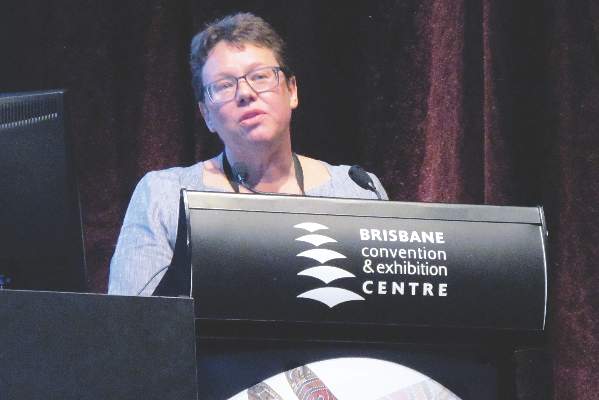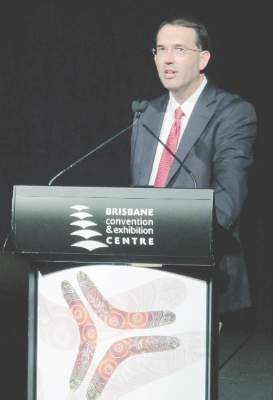User login
Held every two years STI & AIDS World Congress 2015: Joint Meeting of the 21st ISSTDR and 15th IUSTI
Product pipeline promising for STI, pregnancy prevention
BRISBANE, AUSTRALIA – Multipurpose technologies such as vaginal rings, gels, and new types of diaphragms have the potential to address a gap in products that can prevent both unwanted pregnancy and sexually transmitted infections.
The emerging pipeline of new multipurpose technologies could deliver significant public health benefits, particularly to women, Dr. Vivian Black said at the World STI & HIV Congress 2015.
“We know that each year there are over 74 million unintended pregnancies, and 36 million of these end up in abortions, many of which are conducted in unsafe environments,” said Dr. Black, director for clinical programs at the Wits Reproductive Health and HIV Institute in Johannesburg, South Africa. “Against this backdrop, we also are very aware of the HIV epidemic and how that impacts, particularly on women in the same resource-poor environments and in particular in the African region.”
Multipurpose technologies – which are generally initiated by women – can help address situations of power imbalance within relationships and sexual inequality that mean women may struggle to negotiate effective use of condoms.
One such multipurpose technology is the one-size-fits-all SILCS diaphragm, which is made of silicone and is sold under the brand name Caya diaphragm. The device has been approved for use in more than 20 countries and was granted market clearance by the Food and Drug Administration in 2014.
“End users have given feedback that it’s a comfortable product to use. Male partners find that it doesn’t impact on sexual experience, although some even claimed it might improve their sexual experience, which is a good outcome,” Dr. Black said.
The diaphragm can be combined with a topical contraceptive, and there is the potential to use it with a topical microbicide and other preventive agents.
Vaginal gels are another example of multipurpose technologies. A 1% tenofovir gel to prevent HIV and herpes simplex virus infection is currently in phase III trials, while phase I trials are being conducted to explore the impact of a gel combining nonnucleoside reverse transcriptase inhibitor MIV-150, zinc acetate, and carrageenan, Dr. Black said.
Several multipurpose vaginal rings are also in development, containing sustained-release formulations of contraceptive agents such as levonorgesterel in combination with an anti-infective agent such as tenofovir, or combining anti-infective agents to prevent both HIV and other STIs.
Work is also ongoing in the area of vaccine development.
“Currently we have very effective vaccines for human papillomavirus and hepatitis B, but we hope that in 20 years or so we might have a single vaccine that we could give that would prevent a whole host of STIs including HIV, gonorrhea, chlamydia, trichomoniasis, and herpes simplex virus,” Dr. Black said.
In the United States, the focus of multipurpose technologies has been less on HIV prevention and more on the prevention of unwanted pregnancies and STIs, Dr. Black said. But she stressed that the marketing of multipurpose technologies must be done carefully to avoid “tarnishing” their image by associating them with STI or HIV prevention.
“I think that’s a very important thing that when it comes to marketing, it’s not about STI prevention but about enhancing intimacy and things like that,” Dr. Black said in an interview. “The nice thing about multipurpose technologies is you can also switch use, so if, for example, you’ve got a woman whose partner is maybe unfaithful or [she] is not able to negotiate condom usage, she can use a product for contraception and vice versa.”
Dr. Black reported having no relevant financial disclosures.
BRISBANE, AUSTRALIA – Multipurpose technologies such as vaginal rings, gels, and new types of diaphragms have the potential to address a gap in products that can prevent both unwanted pregnancy and sexually transmitted infections.
The emerging pipeline of new multipurpose technologies could deliver significant public health benefits, particularly to women, Dr. Vivian Black said at the World STI & HIV Congress 2015.
“We know that each year there are over 74 million unintended pregnancies, and 36 million of these end up in abortions, many of which are conducted in unsafe environments,” said Dr. Black, director for clinical programs at the Wits Reproductive Health and HIV Institute in Johannesburg, South Africa. “Against this backdrop, we also are very aware of the HIV epidemic and how that impacts, particularly on women in the same resource-poor environments and in particular in the African region.”
Multipurpose technologies – which are generally initiated by women – can help address situations of power imbalance within relationships and sexual inequality that mean women may struggle to negotiate effective use of condoms.
One such multipurpose technology is the one-size-fits-all SILCS diaphragm, which is made of silicone and is sold under the brand name Caya diaphragm. The device has been approved for use in more than 20 countries and was granted market clearance by the Food and Drug Administration in 2014.
“End users have given feedback that it’s a comfortable product to use. Male partners find that it doesn’t impact on sexual experience, although some even claimed it might improve their sexual experience, which is a good outcome,” Dr. Black said.
The diaphragm can be combined with a topical contraceptive, and there is the potential to use it with a topical microbicide and other preventive agents.
Vaginal gels are another example of multipurpose technologies. A 1% tenofovir gel to prevent HIV and herpes simplex virus infection is currently in phase III trials, while phase I trials are being conducted to explore the impact of a gel combining nonnucleoside reverse transcriptase inhibitor MIV-150, zinc acetate, and carrageenan, Dr. Black said.
Several multipurpose vaginal rings are also in development, containing sustained-release formulations of contraceptive agents such as levonorgesterel in combination with an anti-infective agent such as tenofovir, or combining anti-infective agents to prevent both HIV and other STIs.
Work is also ongoing in the area of vaccine development.
“Currently we have very effective vaccines for human papillomavirus and hepatitis B, but we hope that in 20 years or so we might have a single vaccine that we could give that would prevent a whole host of STIs including HIV, gonorrhea, chlamydia, trichomoniasis, and herpes simplex virus,” Dr. Black said.
In the United States, the focus of multipurpose technologies has been less on HIV prevention and more on the prevention of unwanted pregnancies and STIs, Dr. Black said. But she stressed that the marketing of multipurpose technologies must be done carefully to avoid “tarnishing” their image by associating them with STI or HIV prevention.
“I think that’s a very important thing that when it comes to marketing, it’s not about STI prevention but about enhancing intimacy and things like that,” Dr. Black said in an interview. “The nice thing about multipurpose technologies is you can also switch use, so if, for example, you’ve got a woman whose partner is maybe unfaithful or [she] is not able to negotiate condom usage, she can use a product for contraception and vice versa.”
Dr. Black reported having no relevant financial disclosures.
BRISBANE, AUSTRALIA – Multipurpose technologies such as vaginal rings, gels, and new types of diaphragms have the potential to address a gap in products that can prevent both unwanted pregnancy and sexually transmitted infections.
The emerging pipeline of new multipurpose technologies could deliver significant public health benefits, particularly to women, Dr. Vivian Black said at the World STI & HIV Congress 2015.
“We know that each year there are over 74 million unintended pregnancies, and 36 million of these end up in abortions, many of which are conducted in unsafe environments,” said Dr. Black, director for clinical programs at the Wits Reproductive Health and HIV Institute in Johannesburg, South Africa. “Against this backdrop, we also are very aware of the HIV epidemic and how that impacts, particularly on women in the same resource-poor environments and in particular in the African region.”
Multipurpose technologies – which are generally initiated by women – can help address situations of power imbalance within relationships and sexual inequality that mean women may struggle to negotiate effective use of condoms.
One such multipurpose technology is the one-size-fits-all SILCS diaphragm, which is made of silicone and is sold under the brand name Caya diaphragm. The device has been approved for use in more than 20 countries and was granted market clearance by the Food and Drug Administration in 2014.
“End users have given feedback that it’s a comfortable product to use. Male partners find that it doesn’t impact on sexual experience, although some even claimed it might improve their sexual experience, which is a good outcome,” Dr. Black said.
The diaphragm can be combined with a topical contraceptive, and there is the potential to use it with a topical microbicide and other preventive agents.
Vaginal gels are another example of multipurpose technologies. A 1% tenofovir gel to prevent HIV and herpes simplex virus infection is currently in phase III trials, while phase I trials are being conducted to explore the impact of a gel combining nonnucleoside reverse transcriptase inhibitor MIV-150, zinc acetate, and carrageenan, Dr. Black said.
Several multipurpose vaginal rings are also in development, containing sustained-release formulations of contraceptive agents such as levonorgesterel in combination with an anti-infective agent such as tenofovir, or combining anti-infective agents to prevent both HIV and other STIs.
Work is also ongoing in the area of vaccine development.
“Currently we have very effective vaccines for human papillomavirus and hepatitis B, but we hope that in 20 years or so we might have a single vaccine that we could give that would prevent a whole host of STIs including HIV, gonorrhea, chlamydia, trichomoniasis, and herpes simplex virus,” Dr. Black said.
In the United States, the focus of multipurpose technologies has been less on HIV prevention and more on the prevention of unwanted pregnancies and STIs, Dr. Black said. But she stressed that the marketing of multipurpose technologies must be done carefully to avoid “tarnishing” their image by associating them with STI or HIV prevention.
“I think that’s a very important thing that when it comes to marketing, it’s not about STI prevention but about enhancing intimacy and things like that,” Dr. Black said in an interview. “The nice thing about multipurpose technologies is you can also switch use, so if, for example, you’ve got a woman whose partner is maybe unfaithful or [she] is not able to negotiate condom usage, she can use a product for contraception and vice versa.”
Dr. Black reported having no relevant financial disclosures.
EXPERT ANALYSIS FROM THE WORLD STI & HIV CONGRESS 2015
Self-collected penile swabs provide accurate alternative for STI testing
BRISBANE, AUSTRALIA – Self-collected penile-meatal swabs perform as well as urethral swabs for the detection of chlamydia, gonorrhea, trichomoniasis, and Mycoplasma genitalium, but are more acceptable to men, according to a case-control study.
Findings presented at the World STI & HIV Congress 2015 showed there were no statistically significant differences in accuracy between the self-collected penile swabs and clinician-collected urethral swabs in nucleic acid amplification testing (NAAT).
The study enrolled 203 men attending an STI clinic in Baltimore, who were undergoing urethral swabs and who were then invited to perform their own penile swab.
The swabs were placed in separate transport medium and were tested separately with NAAT for four organisms: Chlamydia trachomatis, Neisseria gonorrhoeae, Trichomonas vaginalis, and Mycoplasma genitalium.
• For Chlamydia trachomatis, the self-collected penile swab showed a sensitivity of 96.8% and specificity of 98.8%, with no statistically significant difference from urethral swabs (P = .625).
• For Neisseria gonorrhoeae, the penile swab had a sensitivity of 100% and specificity of 98.9%, with no statistically significant difference from urethral swabs (P = .248).
• For Trichomonas vaginalis, the sensitivity was 85% and specificity was 96.8%, with no statistically significant difference from urethral swabs (P = .344).
• For Mycoplasma genitalium the sensitivity was 79.3% and specificity was 99.4%, with no statistically significant difference from urethral swabs (P = .70).
Charlotte A. Gaydos, Dr.P.H., director of the Johns Hopkins Center for the Development of Point of Care Tests for Sexually Transmitted Diseases in Baltimore, said that despite the men’s initial concerns about undergoing another swab after the discomfort of the urethral swab, all of them preferred the self-collected penile swab.
“We think that in the future such self-collected penile swabs could expedite express visits, for example, in an STD clinic,” Dr. Gaydos said. “The swab also shows promise as being one swab type that could be tested for four different STIs.”
An audience member raised the possibility that the penile swab specimen could have been inadvertently contaminated with biological material brought up from the prior urethral swab. Dr. Gaydos acknowledged the lack of randomization in terms of the timing of each swab could have affected the results.
She also pointed out that the study was done in largely symptomatic rather than asymptomatic men, and a trial is needed to address the randomization issue and also to explore the approach in asymptomatic men.
“We do feel that we are with the penile swab where we were 10 years ago with the self-collected vaginal swab,” Dr. Gaydos said in an interview. “We hope it will generate more interest in the self-collected penile swab, because the urethral is painful.”
Dr. Gaydos reported research funding and lectureships with Becton Dickinson, Gen-Probe/Hologic, Abbott Molecular Diagnostics, Siemens Healthcare Diagnostics, Sekisui, and Cepheid.
BRISBANE, AUSTRALIA – Self-collected penile-meatal swabs perform as well as urethral swabs for the detection of chlamydia, gonorrhea, trichomoniasis, and Mycoplasma genitalium, but are more acceptable to men, according to a case-control study.
Findings presented at the World STI & HIV Congress 2015 showed there were no statistically significant differences in accuracy between the self-collected penile swabs and clinician-collected urethral swabs in nucleic acid amplification testing (NAAT).
The study enrolled 203 men attending an STI clinic in Baltimore, who were undergoing urethral swabs and who were then invited to perform their own penile swab.
The swabs were placed in separate transport medium and were tested separately with NAAT for four organisms: Chlamydia trachomatis, Neisseria gonorrhoeae, Trichomonas vaginalis, and Mycoplasma genitalium.
• For Chlamydia trachomatis, the self-collected penile swab showed a sensitivity of 96.8% and specificity of 98.8%, with no statistically significant difference from urethral swabs (P = .625).
• For Neisseria gonorrhoeae, the penile swab had a sensitivity of 100% and specificity of 98.9%, with no statistically significant difference from urethral swabs (P = .248).
• For Trichomonas vaginalis, the sensitivity was 85% and specificity was 96.8%, with no statistically significant difference from urethral swabs (P = .344).
• For Mycoplasma genitalium the sensitivity was 79.3% and specificity was 99.4%, with no statistically significant difference from urethral swabs (P = .70).
Charlotte A. Gaydos, Dr.P.H., director of the Johns Hopkins Center for the Development of Point of Care Tests for Sexually Transmitted Diseases in Baltimore, said that despite the men’s initial concerns about undergoing another swab after the discomfort of the urethral swab, all of them preferred the self-collected penile swab.
“We think that in the future such self-collected penile swabs could expedite express visits, for example, in an STD clinic,” Dr. Gaydos said. “The swab also shows promise as being one swab type that could be tested for four different STIs.”
An audience member raised the possibility that the penile swab specimen could have been inadvertently contaminated with biological material brought up from the prior urethral swab. Dr. Gaydos acknowledged the lack of randomization in terms of the timing of each swab could have affected the results.
She also pointed out that the study was done in largely symptomatic rather than asymptomatic men, and a trial is needed to address the randomization issue and also to explore the approach in asymptomatic men.
“We do feel that we are with the penile swab where we were 10 years ago with the self-collected vaginal swab,” Dr. Gaydos said in an interview. “We hope it will generate more interest in the self-collected penile swab, because the urethral is painful.”
Dr. Gaydos reported research funding and lectureships with Becton Dickinson, Gen-Probe/Hologic, Abbott Molecular Diagnostics, Siemens Healthcare Diagnostics, Sekisui, and Cepheid.
BRISBANE, AUSTRALIA – Self-collected penile-meatal swabs perform as well as urethral swabs for the detection of chlamydia, gonorrhea, trichomoniasis, and Mycoplasma genitalium, but are more acceptable to men, according to a case-control study.
Findings presented at the World STI & HIV Congress 2015 showed there were no statistically significant differences in accuracy between the self-collected penile swabs and clinician-collected urethral swabs in nucleic acid amplification testing (NAAT).
The study enrolled 203 men attending an STI clinic in Baltimore, who were undergoing urethral swabs and who were then invited to perform their own penile swab.
The swabs were placed in separate transport medium and were tested separately with NAAT for four organisms: Chlamydia trachomatis, Neisseria gonorrhoeae, Trichomonas vaginalis, and Mycoplasma genitalium.
• For Chlamydia trachomatis, the self-collected penile swab showed a sensitivity of 96.8% and specificity of 98.8%, with no statistically significant difference from urethral swabs (P = .625).
• For Neisseria gonorrhoeae, the penile swab had a sensitivity of 100% and specificity of 98.9%, with no statistically significant difference from urethral swabs (P = .248).
• For Trichomonas vaginalis, the sensitivity was 85% and specificity was 96.8%, with no statistically significant difference from urethral swabs (P = .344).
• For Mycoplasma genitalium the sensitivity was 79.3% and specificity was 99.4%, with no statistically significant difference from urethral swabs (P = .70).
Charlotte A. Gaydos, Dr.P.H., director of the Johns Hopkins Center for the Development of Point of Care Tests for Sexually Transmitted Diseases in Baltimore, said that despite the men’s initial concerns about undergoing another swab after the discomfort of the urethral swab, all of them preferred the self-collected penile swab.
“We think that in the future such self-collected penile swabs could expedite express visits, for example, in an STD clinic,” Dr. Gaydos said. “The swab also shows promise as being one swab type that could be tested for four different STIs.”
An audience member raised the possibility that the penile swab specimen could have been inadvertently contaminated with biological material brought up from the prior urethral swab. Dr. Gaydos acknowledged the lack of randomization in terms of the timing of each swab could have affected the results.
She also pointed out that the study was done in largely symptomatic rather than asymptomatic men, and a trial is needed to address the randomization issue and also to explore the approach in asymptomatic men.
“We do feel that we are with the penile swab where we were 10 years ago with the self-collected vaginal swab,” Dr. Gaydos said in an interview. “We hope it will generate more interest in the self-collected penile swab, because the urethral is painful.”
Dr. Gaydos reported research funding and lectureships with Becton Dickinson, Gen-Probe/Hologic, Abbott Molecular Diagnostics, Siemens Healthcare Diagnostics, Sekisui, and Cepheid.
FROM WORLD STI & HIV CONGRESS 2015
Key clinical point:Self-collected penile-meatal swabs perform as well as urethral swabs for the detection of chlamydia, gonorrhea, trichomoniasis, and Mycoplasma genitalium.
Major finding: There were no statistically significant differences in the sensitivity and specificity of self-collected penile swabs versus clinician-collected urethral swabs across four STIs.
Data source: Case-control study in 203 men attending an STI clinic.
Disclosures: Dr. Gaydos disclosed research funding and lectureships with Becton Dickinson, Gen-Probe/Hologic, Abbott Molecular Diagnostics, Siemens Healthcare Diagnostics, Sekisui, and Cepheid.
Link between bacterial vaginosis and STIs unclear
BRISBANE, AUSTRALIA – Evidence is building for a link between bacterial vaginosis and an increased risk of sexually transmitted infections, but clinical trial data demonstrating that treating vaginosis will reduce STI risk is still needed.
“We don’t expect that bacterial vaginosis is the direct cause of STIs but rather they influence their risk,” Dr. R. Scott McClelland of the University of Washington, Seattle, said at the World STI and HIV Congress 2015. “We’ve seen plenty of studies that make a nice temporal argument that bacterial vaginosis precedes STIs and some evidence of a biological gradient.”
He outlined some of the major studies that explore the relationship between bacterial vaginosis and HIV, herpes, gonorrhea, chlamydia, and trichomoniasis.
In the case of HIV, Dr. McClelland cited data from the Mombasa cohort of high-risk women in Kenya that suggested that bacterial vaginosis was the second largest contributor to HIV risk after herpes simplex virus type 2, representing around 17% of the population-attributable risk (AIDS. 2015 Jun 1;29[9]:1077-85. doi: 10.1097/QAD.0000000000000646). There is also evidence that HIV-positive women tended to have reduced vaginal lactobacilli and increased bacterial diversity, compared with women without HIV, he said.
Four major studies also showed a generally significant 1.6- to 2.4-fold increase in the risk of herpes simplex virus type 2 following bacterial vaginosis, Dr. McClelland said. Similarly with HPV infection, studies suggest a 1.2- to 2.4-fold increase in the risk of HPV infection after bacterial infection.
“With HPV, some of the most interesting new work is exploring how bacterial vaginosis may influence the outcomes of HPV infection in terms of progression towards cervical dysplasia and cervical cancer,” Dr. McClelland said.
The evidence is somewhat mixed for bacterial STIs, with some evidence for a link between bacterial vaginosis and chlamydia and gonorrhea.
There is strong but unadjusted evidence of a link between bacterial vaginosis and Mycoplasma genitalium infection from the Mombasa cohort study, which also showed a dose-response effect between Nugent score and Mycoplasma genitalium risk, he said.
“I think these data are really intriguing; I think that they suggest that we might be able to substantially reduce women’s risk of acquiring STIs if we could control their vaginal microbiota better,” Dr. McClelland said in an interview.
An audience member noted that the therapeutic armamentarium for bacterial vaginosis was not ideal, but asked at what point clinicians should start paying more attention to asymptomatic bacterial vaginosis.
“I don’t think we should start treating asymptomatic bacterial vaginosis without clear clinical trial evidence that there’s a benefit to doing that, and right now we don’t have it,” Dr. McClelland said.
Another study presented at the conference – coauthored by Dr. McClelland – has taken a step toward addressing this lack of evidence with a randomized controlled trial examining the impact of periodic presumptive treatment of bacterial vaginosis on STI risk.
Researchers randomized 221 women in Kenya and the United States who were not infected with HIV to intravaginal metronidazole plus miconazole, or placebo for 5 consecutive nights each month for a year. The intervention successfully reduced the incidence of bacterial vaginosis and achieved a significant reduction in the incidence of chlamydia and gonorrhea, but only when the two infections were assessed as a combined endpoint, according to Dr. McClelland.
Dr. McClelland reported receiving past consulting and lecture fees from Embil Pharmaceutical Co., and a current research grant from Hologic Inc.
BRISBANE, AUSTRALIA – Evidence is building for a link between bacterial vaginosis and an increased risk of sexually transmitted infections, but clinical trial data demonstrating that treating vaginosis will reduce STI risk is still needed.
“We don’t expect that bacterial vaginosis is the direct cause of STIs but rather they influence their risk,” Dr. R. Scott McClelland of the University of Washington, Seattle, said at the World STI and HIV Congress 2015. “We’ve seen plenty of studies that make a nice temporal argument that bacterial vaginosis precedes STIs and some evidence of a biological gradient.”
He outlined some of the major studies that explore the relationship between bacterial vaginosis and HIV, herpes, gonorrhea, chlamydia, and trichomoniasis.
In the case of HIV, Dr. McClelland cited data from the Mombasa cohort of high-risk women in Kenya that suggested that bacterial vaginosis was the second largest contributor to HIV risk after herpes simplex virus type 2, representing around 17% of the population-attributable risk (AIDS. 2015 Jun 1;29[9]:1077-85. doi: 10.1097/QAD.0000000000000646). There is also evidence that HIV-positive women tended to have reduced vaginal lactobacilli and increased bacterial diversity, compared with women without HIV, he said.
Four major studies also showed a generally significant 1.6- to 2.4-fold increase in the risk of herpes simplex virus type 2 following bacterial vaginosis, Dr. McClelland said. Similarly with HPV infection, studies suggest a 1.2- to 2.4-fold increase in the risk of HPV infection after bacterial infection.
“With HPV, some of the most interesting new work is exploring how bacterial vaginosis may influence the outcomes of HPV infection in terms of progression towards cervical dysplasia and cervical cancer,” Dr. McClelland said.
The evidence is somewhat mixed for bacterial STIs, with some evidence for a link between bacterial vaginosis and chlamydia and gonorrhea.
There is strong but unadjusted evidence of a link between bacterial vaginosis and Mycoplasma genitalium infection from the Mombasa cohort study, which also showed a dose-response effect between Nugent score and Mycoplasma genitalium risk, he said.
“I think these data are really intriguing; I think that they suggest that we might be able to substantially reduce women’s risk of acquiring STIs if we could control their vaginal microbiota better,” Dr. McClelland said in an interview.
An audience member noted that the therapeutic armamentarium for bacterial vaginosis was not ideal, but asked at what point clinicians should start paying more attention to asymptomatic bacterial vaginosis.
“I don’t think we should start treating asymptomatic bacterial vaginosis without clear clinical trial evidence that there’s a benefit to doing that, and right now we don’t have it,” Dr. McClelland said.
Another study presented at the conference – coauthored by Dr. McClelland – has taken a step toward addressing this lack of evidence with a randomized controlled trial examining the impact of periodic presumptive treatment of bacterial vaginosis on STI risk.
Researchers randomized 221 women in Kenya and the United States who were not infected with HIV to intravaginal metronidazole plus miconazole, or placebo for 5 consecutive nights each month for a year. The intervention successfully reduced the incidence of bacterial vaginosis and achieved a significant reduction in the incidence of chlamydia and gonorrhea, but only when the two infections were assessed as a combined endpoint, according to Dr. McClelland.
Dr. McClelland reported receiving past consulting and lecture fees from Embil Pharmaceutical Co., and a current research grant from Hologic Inc.
BRISBANE, AUSTRALIA – Evidence is building for a link between bacterial vaginosis and an increased risk of sexually transmitted infections, but clinical trial data demonstrating that treating vaginosis will reduce STI risk is still needed.
“We don’t expect that bacterial vaginosis is the direct cause of STIs but rather they influence their risk,” Dr. R. Scott McClelland of the University of Washington, Seattle, said at the World STI and HIV Congress 2015. “We’ve seen plenty of studies that make a nice temporal argument that bacterial vaginosis precedes STIs and some evidence of a biological gradient.”
He outlined some of the major studies that explore the relationship between bacterial vaginosis and HIV, herpes, gonorrhea, chlamydia, and trichomoniasis.
In the case of HIV, Dr. McClelland cited data from the Mombasa cohort of high-risk women in Kenya that suggested that bacterial vaginosis was the second largest contributor to HIV risk after herpes simplex virus type 2, representing around 17% of the population-attributable risk (AIDS. 2015 Jun 1;29[9]:1077-85. doi: 10.1097/QAD.0000000000000646). There is also evidence that HIV-positive women tended to have reduced vaginal lactobacilli and increased bacterial diversity, compared with women without HIV, he said.
Four major studies also showed a generally significant 1.6- to 2.4-fold increase in the risk of herpes simplex virus type 2 following bacterial vaginosis, Dr. McClelland said. Similarly with HPV infection, studies suggest a 1.2- to 2.4-fold increase in the risk of HPV infection after bacterial infection.
“With HPV, some of the most interesting new work is exploring how bacterial vaginosis may influence the outcomes of HPV infection in terms of progression towards cervical dysplasia and cervical cancer,” Dr. McClelland said.
The evidence is somewhat mixed for bacterial STIs, with some evidence for a link between bacterial vaginosis and chlamydia and gonorrhea.
There is strong but unadjusted evidence of a link between bacterial vaginosis and Mycoplasma genitalium infection from the Mombasa cohort study, which also showed a dose-response effect between Nugent score and Mycoplasma genitalium risk, he said.
“I think these data are really intriguing; I think that they suggest that we might be able to substantially reduce women’s risk of acquiring STIs if we could control their vaginal microbiota better,” Dr. McClelland said in an interview.
An audience member noted that the therapeutic armamentarium for bacterial vaginosis was not ideal, but asked at what point clinicians should start paying more attention to asymptomatic bacterial vaginosis.
“I don’t think we should start treating asymptomatic bacterial vaginosis without clear clinical trial evidence that there’s a benefit to doing that, and right now we don’t have it,” Dr. McClelland said.
Another study presented at the conference – coauthored by Dr. McClelland – has taken a step toward addressing this lack of evidence with a randomized controlled trial examining the impact of periodic presumptive treatment of bacterial vaginosis on STI risk.
Researchers randomized 221 women in Kenya and the United States who were not infected with HIV to intravaginal metronidazole plus miconazole, or placebo for 5 consecutive nights each month for a year. The intervention successfully reduced the incidence of bacterial vaginosis and achieved a significant reduction in the incidence of chlamydia and gonorrhea, but only when the two infections were assessed as a combined endpoint, according to Dr. McClelland.
Dr. McClelland reported receiving past consulting and lecture fees from Embil Pharmaceutical Co., and a current research grant from Hologic Inc.
EXPERT ANALYSIS FROM WORLD STI & HIV CONGRESS 2015
Ebola virus in semen raises possibility of sexual transmission
BRISBANE, AUSTRALIA – The first possible case of sexual transmission of the Ebola virus has been recorded in Liberia, Dr. Nicola Low reported at the World STI & HIV Congress 2015.
The woman diagnosed with the Ebola virus had no contact with any other Ebola patients, despite extensive contact tracing. The only possible source of the virus was sexual contact with a man who had been ill with the disease and recovered 6 months before he had contact with her.
Dr. Low, of the Institute of Social and Preventive Medicine at the University of Bern in Switzerland, said that while only a partial genetic sequence was available for the male Ebola survivor’s virus, the sequence was very similar to that of the virus taken from the infected woman.
“It cannot be definitively confirmed as sexual transmission, but it is highly suggestive,” Dr. Low told conference attendees.
Dr. Low showed data from a study of 100 male Ebola virus survivors, which demonstrated that the virus could persist in semen for up to 9 months after the first onset of symptoms.
“In the first 3 months after symptom onset, all men had Ebola virus detected in semen and even after 6 months, the majority still had Ebola virus detected in semen, so the persistence in semen seems to be far longer than we have previously suspected,” she said.
There is growing evidence of “immunologically privileged” sites, such as the gonads and eyes, where the virus can persist long after the disease itself has resolved, Dr. Low said.
The persistence and potential sexual transmission of the Ebola virus has implications for management of Ebola virus disease survivors, but also demands further research, Dr. Low said.
“We need this information because it needs to [inform] safe sex guidelines to tell people how to look after themselves and protect their partners during an Ebola epidemic,” she said. “The advice is that men who have had Ebola should be offered semen testing monthly until they have two negative reverse transcriptase PCR [tests], and if they have had no semen testing, they should avoid sex or have [only] safe sex for at least 6 months after onset of symptoms.”
Despite the presence of Ebola virus in semen, Dr. Low said the likelihood of sexual transmission appears to be low.
“Our assumption is that the viral load in semen is probably not very high, but we don’t know that for sure,” Dr. Low said in an interview. “If it’s not really very infectious, then it’s not going to cause very many cases.”
Dr. Low reported having no financial disclosures.
BRISBANE, AUSTRALIA – The first possible case of sexual transmission of the Ebola virus has been recorded in Liberia, Dr. Nicola Low reported at the World STI & HIV Congress 2015.
The woman diagnosed with the Ebola virus had no contact with any other Ebola patients, despite extensive contact tracing. The only possible source of the virus was sexual contact with a man who had been ill with the disease and recovered 6 months before he had contact with her.
Dr. Low, of the Institute of Social and Preventive Medicine at the University of Bern in Switzerland, said that while only a partial genetic sequence was available for the male Ebola survivor’s virus, the sequence was very similar to that of the virus taken from the infected woman.
“It cannot be definitively confirmed as sexual transmission, but it is highly suggestive,” Dr. Low told conference attendees.
Dr. Low showed data from a study of 100 male Ebola virus survivors, which demonstrated that the virus could persist in semen for up to 9 months after the first onset of symptoms.
“In the first 3 months after symptom onset, all men had Ebola virus detected in semen and even after 6 months, the majority still had Ebola virus detected in semen, so the persistence in semen seems to be far longer than we have previously suspected,” she said.
There is growing evidence of “immunologically privileged” sites, such as the gonads and eyes, where the virus can persist long after the disease itself has resolved, Dr. Low said.
The persistence and potential sexual transmission of the Ebola virus has implications for management of Ebola virus disease survivors, but also demands further research, Dr. Low said.
“We need this information because it needs to [inform] safe sex guidelines to tell people how to look after themselves and protect their partners during an Ebola epidemic,” she said. “The advice is that men who have had Ebola should be offered semen testing monthly until they have two negative reverse transcriptase PCR [tests], and if they have had no semen testing, they should avoid sex or have [only] safe sex for at least 6 months after onset of symptoms.”
Despite the presence of Ebola virus in semen, Dr. Low said the likelihood of sexual transmission appears to be low.
“Our assumption is that the viral load in semen is probably not very high, but we don’t know that for sure,” Dr. Low said in an interview. “If it’s not really very infectious, then it’s not going to cause very many cases.”
Dr. Low reported having no financial disclosures.
BRISBANE, AUSTRALIA – The first possible case of sexual transmission of the Ebola virus has been recorded in Liberia, Dr. Nicola Low reported at the World STI & HIV Congress 2015.
The woman diagnosed with the Ebola virus had no contact with any other Ebola patients, despite extensive contact tracing. The only possible source of the virus was sexual contact with a man who had been ill with the disease and recovered 6 months before he had contact with her.
Dr. Low, of the Institute of Social and Preventive Medicine at the University of Bern in Switzerland, said that while only a partial genetic sequence was available for the male Ebola survivor’s virus, the sequence was very similar to that of the virus taken from the infected woman.
“It cannot be definitively confirmed as sexual transmission, but it is highly suggestive,” Dr. Low told conference attendees.
Dr. Low showed data from a study of 100 male Ebola virus survivors, which demonstrated that the virus could persist in semen for up to 9 months after the first onset of symptoms.
“In the first 3 months after symptom onset, all men had Ebola virus detected in semen and even after 6 months, the majority still had Ebola virus detected in semen, so the persistence in semen seems to be far longer than we have previously suspected,” she said.
There is growing evidence of “immunologically privileged” sites, such as the gonads and eyes, where the virus can persist long after the disease itself has resolved, Dr. Low said.
The persistence and potential sexual transmission of the Ebola virus has implications for management of Ebola virus disease survivors, but also demands further research, Dr. Low said.
“We need this information because it needs to [inform] safe sex guidelines to tell people how to look after themselves and protect their partners during an Ebola epidemic,” she said. “The advice is that men who have had Ebola should be offered semen testing monthly until they have two negative reverse transcriptase PCR [tests], and if they have had no semen testing, they should avoid sex or have [only] safe sex for at least 6 months after onset of symptoms.”
Despite the presence of Ebola virus in semen, Dr. Low said the likelihood of sexual transmission appears to be low.
“Our assumption is that the viral load in semen is probably not very high, but we don’t know that for sure,” Dr. Low said in an interview. “If it’s not really very infectious, then it’s not going to cause very many cases.”
Dr. Low reported having no financial disclosures.
EXPERT ANALYSIS FROM THE WORLD STI & HIV CONGRESS 2015
Expert: Be alert for acute HIV infection
BRISBANE, AUSTRALIA – Individuals with acute HIV infection should be treated immediately to limit immunological damage and reduce their heightened risk of transmission, Dr. Myron Cohen said at the World STI & HIV Congress 2015.
Acute HIV infection has both individual and public health consequences, he said.
“The notion that universal test and treat doesn’t apply to people who come in with fever and headache and new infection, I do not believe is appropriate,” said Dr. Cohen, associate vice chancellor for global health at the University of North Carolina, Chapel Hill. “I can’t tell you how painful it has been over the last 10 years to try to explain to people that it doesn’t make sense not to treat people immediately.”
In acute HIV infection, there is a window of time during which the virus is replicating in tissues but is not yet in the blood, so individuals would be HIV-antibody negative but HIV-RNA positive, according to Dr. Cohen.
This acute period is a time when the virus achieves as high a concentration as will ever be reached over the course of infection – sometimes as high as five million copies of the virus.
“During the course of acute infection, three problems are going to be important,” he said. “Transmission risk is very high as the variant wants to go to the next person. All the compartments in the body are seeded including the brain and the genital tract and so we have to start worrying about central nervous system disease. And latency occurs, so the virus integrates into the host genetic material.”
From an immunological perspective, research suggests that patients’ CD4 cell counts never quite recover from this early viremia, leading to irreparable damage to the immune system, he noted.
Dr. Cohen said that treating acute infection with antiretroviral drugs also reduced the latent pool of the virus. “The focus on a cure [for HIV infection] will probably initially focus on people treated during acute infection because the latent pool is smallest, and that’s our best chance,” he said.
This effect is already being demonstrated in patients who receive early antiretroviral therapy and are able to go off therapy for long periods of time without the virus rebounding.
There also are significant public health implications in treating or not treating people with acute infection, Dr. Cohen said, citing studies suggesting a significant proportion of new infections can be attributed to an index patient with acute infection.
Treating acute infection could therefore act as a “cluster buster,” he said.
Describing his position as controversial, Dr. Cohen said there has been debate over whether resources could, or should, be spent identifying individuals in the seroconversion phase of infection.
“Sensitizing people to recognizing acute infection is the next step,” he said in an interview, pointing out that current rapid point-of-care tests were not as effective in detecting acute infection.
“A person whose lifestyle appears to put them at risk, with a fever and a headache … anytime you’re looking at mono or any other viruses, do an HIV test and if it’s positive you treat them.”
Dr. Cohen reported having no financial disclosures.
BRISBANE, AUSTRALIA – Individuals with acute HIV infection should be treated immediately to limit immunological damage and reduce their heightened risk of transmission, Dr. Myron Cohen said at the World STI & HIV Congress 2015.
Acute HIV infection has both individual and public health consequences, he said.
“The notion that universal test and treat doesn’t apply to people who come in with fever and headache and new infection, I do not believe is appropriate,” said Dr. Cohen, associate vice chancellor for global health at the University of North Carolina, Chapel Hill. “I can’t tell you how painful it has been over the last 10 years to try to explain to people that it doesn’t make sense not to treat people immediately.”
In acute HIV infection, there is a window of time during which the virus is replicating in tissues but is not yet in the blood, so individuals would be HIV-antibody negative but HIV-RNA positive, according to Dr. Cohen.
This acute period is a time when the virus achieves as high a concentration as will ever be reached over the course of infection – sometimes as high as five million copies of the virus.
“During the course of acute infection, three problems are going to be important,” he said. “Transmission risk is very high as the variant wants to go to the next person. All the compartments in the body are seeded including the brain and the genital tract and so we have to start worrying about central nervous system disease. And latency occurs, so the virus integrates into the host genetic material.”
From an immunological perspective, research suggests that patients’ CD4 cell counts never quite recover from this early viremia, leading to irreparable damage to the immune system, he noted.
Dr. Cohen said that treating acute infection with antiretroviral drugs also reduced the latent pool of the virus. “The focus on a cure [for HIV infection] will probably initially focus on people treated during acute infection because the latent pool is smallest, and that’s our best chance,” he said.
This effect is already being demonstrated in patients who receive early antiretroviral therapy and are able to go off therapy for long periods of time without the virus rebounding.
There also are significant public health implications in treating or not treating people with acute infection, Dr. Cohen said, citing studies suggesting a significant proportion of new infections can be attributed to an index patient with acute infection.
Treating acute infection could therefore act as a “cluster buster,” he said.
Describing his position as controversial, Dr. Cohen said there has been debate over whether resources could, or should, be spent identifying individuals in the seroconversion phase of infection.
“Sensitizing people to recognizing acute infection is the next step,” he said in an interview, pointing out that current rapid point-of-care tests were not as effective in detecting acute infection.
“A person whose lifestyle appears to put them at risk, with a fever and a headache … anytime you’re looking at mono or any other viruses, do an HIV test and if it’s positive you treat them.”
Dr. Cohen reported having no financial disclosures.
BRISBANE, AUSTRALIA – Individuals with acute HIV infection should be treated immediately to limit immunological damage and reduce their heightened risk of transmission, Dr. Myron Cohen said at the World STI & HIV Congress 2015.
Acute HIV infection has both individual and public health consequences, he said.
“The notion that universal test and treat doesn’t apply to people who come in with fever and headache and new infection, I do not believe is appropriate,” said Dr. Cohen, associate vice chancellor for global health at the University of North Carolina, Chapel Hill. “I can’t tell you how painful it has been over the last 10 years to try to explain to people that it doesn’t make sense not to treat people immediately.”
In acute HIV infection, there is a window of time during which the virus is replicating in tissues but is not yet in the blood, so individuals would be HIV-antibody negative but HIV-RNA positive, according to Dr. Cohen.
This acute period is a time when the virus achieves as high a concentration as will ever be reached over the course of infection – sometimes as high as five million copies of the virus.
“During the course of acute infection, three problems are going to be important,” he said. “Transmission risk is very high as the variant wants to go to the next person. All the compartments in the body are seeded including the brain and the genital tract and so we have to start worrying about central nervous system disease. And latency occurs, so the virus integrates into the host genetic material.”
From an immunological perspective, research suggests that patients’ CD4 cell counts never quite recover from this early viremia, leading to irreparable damage to the immune system, he noted.
Dr. Cohen said that treating acute infection with antiretroviral drugs also reduced the latent pool of the virus. “The focus on a cure [for HIV infection] will probably initially focus on people treated during acute infection because the latent pool is smallest, and that’s our best chance,” he said.
This effect is already being demonstrated in patients who receive early antiretroviral therapy and are able to go off therapy for long periods of time without the virus rebounding.
There also are significant public health implications in treating or not treating people with acute infection, Dr. Cohen said, citing studies suggesting a significant proportion of new infections can be attributed to an index patient with acute infection.
Treating acute infection could therefore act as a “cluster buster,” he said.
Describing his position as controversial, Dr. Cohen said there has been debate over whether resources could, or should, be spent identifying individuals in the seroconversion phase of infection.
“Sensitizing people to recognizing acute infection is the next step,” he said in an interview, pointing out that current rapid point-of-care tests were not as effective in detecting acute infection.
“A person whose lifestyle appears to put them at risk, with a fever and a headache … anytime you’re looking at mono or any other viruses, do an HIV test and if it’s positive you treat them.”
Dr. Cohen reported having no financial disclosures.
EXPERT ANALYSIS FROM THE WORLD STI & HIV CONGRESS 2015
Annual chlamydia screening fails to show significant benefit
BRISBANE, AUSTRALIA – A 3-year randomized, controlled trial of annual chlamydia screening in 16- to 29-year-olds has shown that despite a significant increase in testing rates and diagnoses, screening did not achieve a significant reduction in prevalence when compared with the control group.
Preliminary Australian trial results, presented at the World STI & HIV Congress 2015, showed the rates of testing in the intervention arm increased from around 8% at recruitment to nearly 19% at 3 years, compared with 12% in the control group.
However, there was a nonsignificant 5% difference in the estimated treatment effect between the intervention group and the control group after 3 years.
The Australian Chlamydia Control Effectiveness Pilot (ACCEPt) was a cluster randomized trial, where each unit of randomization contained all the general practice or Aboriginal health clinics within an entire town or rural area.
Jane S. Hocking, Ph.D., the lead researcher, told conference attendees that this approach was taken to minimize the risk of contamination between intervention and control arms, as Australians can switch their primary care physicians at any time.
“One of the most encouraging things that we found was of all the clinics we approached, over 90% agreed to participate, which was a staggeringly high uptake rate,” said Dr. Hocking of the Melbourne School of Population and Global Health at the University of Melbourne.
From 52 areas, the study recruited 66 clinics in the intervention arm and 67 in the control arm, representing a population of around 65,000 individuals in the 16- to 29-year-old age bracket.
Clinic staff in the intervention arm were encouraged and assisted in providing annual chlamydia testing for their 16- to 29-year-old patients, while control clinics were asked to continue with their usual practices.
Chlamydia prevalence was recorded at baseline and 3 years via recruitment and testing of every 16- to 29-year-old who entered each clinic over a period of 3-4 weeks. At baseline, the prevalence of chlamydia was 5.1% in the intervention group and 4.5% in the control group, which dropped to 3.6% and 3.3% respectively after 3 years; however, the difference in the estimated treatment effect between the two groups failed to achieve statistical significance.
But there were some surprises in the findings, Dr. Hocking said, such as a fairly large drop in overall prevalence.
“Our estimated prevalence dropped overall by nearly 30% and we [have] yet to figure out why; we had the same response rate between surveys, same methodology, similar age, and sexual behavior profile in both surveys, so we’re going to see if it’s the consequence of other activities occurring,” she said.
Dr. Hocking told the conference that data on cost-effectiveness and the impact of the intervention on pelvic inflammatory disease hospitalizations were not yet available.
“What we have demonstrated is that chlamydia screening is acceptable and feasible in general practice, and the 90% participation among clinics and 70% participation among patients in the surveys are evidence of this,” Dr. Hocking said.
Dr. Nicola Low, a coinvestigator on the ACCEPt study, said that randomized, controlled trials like this one are challenging to conduct.
“They don’t always come out with expected results, so we’re faced with the challenge of how to interpret these results,” said Dr. Low of the Institute of Social and Preventive Medicine at the University of Bern, Switzerland.
The intervention may have failed to have an impact because the testing rates were not high enough or because the intervention did not continue for long enough, Dr. Hocking said in an interview.
“The modeling suggests that if you get the testing up over 30% for several years, you should see a reduction,” she said.
The trial was supported by Australian Federal and State government health departments and by the National Health and Medical Research Council. The researchers reported having no financial disclosures.
BRISBANE, AUSTRALIA – A 3-year randomized, controlled trial of annual chlamydia screening in 16- to 29-year-olds has shown that despite a significant increase in testing rates and diagnoses, screening did not achieve a significant reduction in prevalence when compared with the control group.
Preliminary Australian trial results, presented at the World STI & HIV Congress 2015, showed the rates of testing in the intervention arm increased from around 8% at recruitment to nearly 19% at 3 years, compared with 12% in the control group.
However, there was a nonsignificant 5% difference in the estimated treatment effect between the intervention group and the control group after 3 years.
The Australian Chlamydia Control Effectiveness Pilot (ACCEPt) was a cluster randomized trial, where each unit of randomization contained all the general practice or Aboriginal health clinics within an entire town or rural area.
Jane S. Hocking, Ph.D., the lead researcher, told conference attendees that this approach was taken to minimize the risk of contamination between intervention and control arms, as Australians can switch their primary care physicians at any time.
“One of the most encouraging things that we found was of all the clinics we approached, over 90% agreed to participate, which was a staggeringly high uptake rate,” said Dr. Hocking of the Melbourne School of Population and Global Health at the University of Melbourne.
From 52 areas, the study recruited 66 clinics in the intervention arm and 67 in the control arm, representing a population of around 65,000 individuals in the 16- to 29-year-old age bracket.
Clinic staff in the intervention arm were encouraged and assisted in providing annual chlamydia testing for their 16- to 29-year-old patients, while control clinics were asked to continue with their usual practices.
Chlamydia prevalence was recorded at baseline and 3 years via recruitment and testing of every 16- to 29-year-old who entered each clinic over a period of 3-4 weeks. At baseline, the prevalence of chlamydia was 5.1% in the intervention group and 4.5% in the control group, which dropped to 3.6% and 3.3% respectively after 3 years; however, the difference in the estimated treatment effect between the two groups failed to achieve statistical significance.
But there were some surprises in the findings, Dr. Hocking said, such as a fairly large drop in overall prevalence.
“Our estimated prevalence dropped overall by nearly 30% and we [have] yet to figure out why; we had the same response rate between surveys, same methodology, similar age, and sexual behavior profile in both surveys, so we’re going to see if it’s the consequence of other activities occurring,” she said.
Dr. Hocking told the conference that data on cost-effectiveness and the impact of the intervention on pelvic inflammatory disease hospitalizations were not yet available.
“What we have demonstrated is that chlamydia screening is acceptable and feasible in general practice, and the 90% participation among clinics and 70% participation among patients in the surveys are evidence of this,” Dr. Hocking said.
Dr. Nicola Low, a coinvestigator on the ACCEPt study, said that randomized, controlled trials like this one are challenging to conduct.
“They don’t always come out with expected results, so we’re faced with the challenge of how to interpret these results,” said Dr. Low of the Institute of Social and Preventive Medicine at the University of Bern, Switzerland.
The intervention may have failed to have an impact because the testing rates were not high enough or because the intervention did not continue for long enough, Dr. Hocking said in an interview.
“The modeling suggests that if you get the testing up over 30% for several years, you should see a reduction,” she said.
The trial was supported by Australian Federal and State government health departments and by the National Health and Medical Research Council. The researchers reported having no financial disclosures.
BRISBANE, AUSTRALIA – A 3-year randomized, controlled trial of annual chlamydia screening in 16- to 29-year-olds has shown that despite a significant increase in testing rates and diagnoses, screening did not achieve a significant reduction in prevalence when compared with the control group.
Preliminary Australian trial results, presented at the World STI & HIV Congress 2015, showed the rates of testing in the intervention arm increased from around 8% at recruitment to nearly 19% at 3 years, compared with 12% in the control group.
However, there was a nonsignificant 5% difference in the estimated treatment effect between the intervention group and the control group after 3 years.
The Australian Chlamydia Control Effectiveness Pilot (ACCEPt) was a cluster randomized trial, where each unit of randomization contained all the general practice or Aboriginal health clinics within an entire town or rural area.
Jane S. Hocking, Ph.D., the lead researcher, told conference attendees that this approach was taken to minimize the risk of contamination between intervention and control arms, as Australians can switch their primary care physicians at any time.
“One of the most encouraging things that we found was of all the clinics we approached, over 90% agreed to participate, which was a staggeringly high uptake rate,” said Dr. Hocking of the Melbourne School of Population and Global Health at the University of Melbourne.
From 52 areas, the study recruited 66 clinics in the intervention arm and 67 in the control arm, representing a population of around 65,000 individuals in the 16- to 29-year-old age bracket.
Clinic staff in the intervention arm were encouraged and assisted in providing annual chlamydia testing for their 16- to 29-year-old patients, while control clinics were asked to continue with their usual practices.
Chlamydia prevalence was recorded at baseline and 3 years via recruitment and testing of every 16- to 29-year-old who entered each clinic over a period of 3-4 weeks. At baseline, the prevalence of chlamydia was 5.1% in the intervention group and 4.5% in the control group, which dropped to 3.6% and 3.3% respectively after 3 years; however, the difference in the estimated treatment effect between the two groups failed to achieve statistical significance.
But there were some surprises in the findings, Dr. Hocking said, such as a fairly large drop in overall prevalence.
“Our estimated prevalence dropped overall by nearly 30% and we [have] yet to figure out why; we had the same response rate between surveys, same methodology, similar age, and sexual behavior profile in both surveys, so we’re going to see if it’s the consequence of other activities occurring,” she said.
Dr. Hocking told the conference that data on cost-effectiveness and the impact of the intervention on pelvic inflammatory disease hospitalizations were not yet available.
“What we have demonstrated is that chlamydia screening is acceptable and feasible in general practice, and the 90% participation among clinics and 70% participation among patients in the surveys are evidence of this,” Dr. Hocking said.
Dr. Nicola Low, a coinvestigator on the ACCEPt study, said that randomized, controlled trials like this one are challenging to conduct.
“They don’t always come out with expected results, so we’re faced with the challenge of how to interpret these results,” said Dr. Low of the Institute of Social and Preventive Medicine at the University of Bern, Switzerland.
The intervention may have failed to have an impact because the testing rates were not high enough or because the intervention did not continue for long enough, Dr. Hocking said in an interview.
“The modeling suggests that if you get the testing up over 30% for several years, you should see a reduction,” she said.
The trial was supported by Australian Federal and State government health departments and by the National Health and Medical Research Council. The researchers reported having no financial disclosures.
FROM THE WORLD STI & HIV CONGRESS 2015
Key clinical point:A 3-year randomized, controlled trial of annual chlamydia screening in 16- to 29-year-olds has failed to achieve a significant reduction in disease prevalence.
Major finding: A randomized, controlled trial of annual chlamydia screening has achieved a nonsignificant 5% difference in estimated treatment effect between the intervention group and controls.
Data source: Randomized controlled cluster trial in 52 rural towns and regions in Australia.
Disclosures: The trial was supported by Australian Federal and State government health departments and by the National Health and Medical Research Council. The researchers reported having no financial disclosures.
Internet-based service increases access to STI testing
BRISBANE, AUSTRALIA – An internet-based testing referral service for sexually transmitted infections could take the pressure off overloaded clinics and reduce barriers to testing, according to new research.
Researchers reported data from a Vancouver-based pilot study of a virtual extension of clinic services called GetCheckedOnline.com. The service was offered to patients who were unable to get an immediate appointment at an STI clinic.
The service, which is being piloted in three clinic settings in Vancouver, is aimed at individuals who are asymptomatic and have not had STI contact.
It enables them to print out a requisition for a test for chlamydia, gonorrhea, syphilis, HIV, or hepatitis C, after completing a sexual history questionnaire.
Negative results are made available through the same website, but individuals who have positive results are asked to contact the clinic to receive their results. The clinic is also notified to ensure follow-up.
Devon Haag of the British Columbia Centre for Disease Control said the pilot was initiated in an attempt to address the long wait times for clinic appointments, with many patients unable to get an appointment for 3-4 weeks.
“We’ve been seeing increasing rates of STIs and at the same time a limited ability and availability of clinical services to meet the demands for timely testing and diagnosis,” Ms. Haag said at the World STI & HIV Congress 2015.
Analysis of data from the first month of the pilot study found that uptake and completion of testing varied considerably across test sites and the source of referral.
Among the 37 individuals who were given access codes to the website after being turned away from the provincial STI clinic – which is located within the BC Centre for Disease Control – 12 individuals went on to create an account on the site, and 10 of those got tested.
Among 108 individuals who contacted that same clinic by telephone and were referred to the service, 80 individuals (74%) created an account, and 62 of them (78%) were tested.
However, uptake was much lower at the two other clinics, with only 7 (19%) of those referred to the website creating an account. Ms. Haag said this may have been due to the nature of the two clinics, which were both located in nonprofit, community-based organizations in an area with a large population of gay men.
“We’ve heard anecdotally from both frontline clinicians and clients, that the clients are really happy with the services that they’re receiving at these clinics and actually would prefer to just come back into the clinic,” she said.
Overall, the pilot resulted in two positive test results and achieved a 2.9% increase in capacity at the provincial clinic.
“We demonstrated that referring clinic turnaways to GetCheckedOnline was feasible and in fact led to new STI diagnoses, so proof of concept was established,” Ms. Haag said.
The researchers also looked at the impact of promotional campaigns aimed at men who have sex with men, finding that these did achieve a significant increase in the number of people creating accounts, but this effect dropped off after the campaign ended.
Ms. Haag said that some clinic patients are now asking to use the online service rather than having to come into the clinic to get tested.
An audience member asked about the number of people who might have dropped out at the sexual health questionnaire stage of the process. While the 1-year data were yet to be analyzed, they do suggest that the questionnaire stage was associated with drop-offs, Ms. Haag said.
She reported having no financial disclosures.
BRISBANE, AUSTRALIA – An internet-based testing referral service for sexually transmitted infections could take the pressure off overloaded clinics and reduce barriers to testing, according to new research.
Researchers reported data from a Vancouver-based pilot study of a virtual extension of clinic services called GetCheckedOnline.com. The service was offered to patients who were unable to get an immediate appointment at an STI clinic.
The service, which is being piloted in three clinic settings in Vancouver, is aimed at individuals who are asymptomatic and have not had STI contact.
It enables them to print out a requisition for a test for chlamydia, gonorrhea, syphilis, HIV, or hepatitis C, after completing a sexual history questionnaire.
Negative results are made available through the same website, but individuals who have positive results are asked to contact the clinic to receive their results. The clinic is also notified to ensure follow-up.
Devon Haag of the British Columbia Centre for Disease Control said the pilot was initiated in an attempt to address the long wait times for clinic appointments, with many patients unable to get an appointment for 3-4 weeks.
“We’ve been seeing increasing rates of STIs and at the same time a limited ability and availability of clinical services to meet the demands for timely testing and diagnosis,” Ms. Haag said at the World STI & HIV Congress 2015.
Analysis of data from the first month of the pilot study found that uptake and completion of testing varied considerably across test sites and the source of referral.
Among the 37 individuals who were given access codes to the website after being turned away from the provincial STI clinic – which is located within the BC Centre for Disease Control – 12 individuals went on to create an account on the site, and 10 of those got tested.
Among 108 individuals who contacted that same clinic by telephone and were referred to the service, 80 individuals (74%) created an account, and 62 of them (78%) were tested.
However, uptake was much lower at the two other clinics, with only 7 (19%) of those referred to the website creating an account. Ms. Haag said this may have been due to the nature of the two clinics, which were both located in nonprofit, community-based organizations in an area with a large population of gay men.
“We’ve heard anecdotally from both frontline clinicians and clients, that the clients are really happy with the services that they’re receiving at these clinics and actually would prefer to just come back into the clinic,” she said.
Overall, the pilot resulted in two positive test results and achieved a 2.9% increase in capacity at the provincial clinic.
“We demonstrated that referring clinic turnaways to GetCheckedOnline was feasible and in fact led to new STI diagnoses, so proof of concept was established,” Ms. Haag said.
The researchers also looked at the impact of promotional campaigns aimed at men who have sex with men, finding that these did achieve a significant increase in the number of people creating accounts, but this effect dropped off after the campaign ended.
Ms. Haag said that some clinic patients are now asking to use the online service rather than having to come into the clinic to get tested.
An audience member asked about the number of people who might have dropped out at the sexual health questionnaire stage of the process. While the 1-year data were yet to be analyzed, they do suggest that the questionnaire stage was associated with drop-offs, Ms. Haag said.
She reported having no financial disclosures.
BRISBANE, AUSTRALIA – An internet-based testing referral service for sexually transmitted infections could take the pressure off overloaded clinics and reduce barriers to testing, according to new research.
Researchers reported data from a Vancouver-based pilot study of a virtual extension of clinic services called GetCheckedOnline.com. The service was offered to patients who were unable to get an immediate appointment at an STI clinic.
The service, which is being piloted in three clinic settings in Vancouver, is aimed at individuals who are asymptomatic and have not had STI contact.
It enables them to print out a requisition for a test for chlamydia, gonorrhea, syphilis, HIV, or hepatitis C, after completing a sexual history questionnaire.
Negative results are made available through the same website, but individuals who have positive results are asked to contact the clinic to receive their results. The clinic is also notified to ensure follow-up.
Devon Haag of the British Columbia Centre for Disease Control said the pilot was initiated in an attempt to address the long wait times for clinic appointments, with many patients unable to get an appointment for 3-4 weeks.
“We’ve been seeing increasing rates of STIs and at the same time a limited ability and availability of clinical services to meet the demands for timely testing and diagnosis,” Ms. Haag said at the World STI & HIV Congress 2015.
Analysis of data from the first month of the pilot study found that uptake and completion of testing varied considerably across test sites and the source of referral.
Among the 37 individuals who were given access codes to the website after being turned away from the provincial STI clinic – which is located within the BC Centre for Disease Control – 12 individuals went on to create an account on the site, and 10 of those got tested.
Among 108 individuals who contacted that same clinic by telephone and were referred to the service, 80 individuals (74%) created an account, and 62 of them (78%) were tested.
However, uptake was much lower at the two other clinics, with only 7 (19%) of those referred to the website creating an account. Ms. Haag said this may have been due to the nature of the two clinics, which were both located in nonprofit, community-based organizations in an area with a large population of gay men.
“We’ve heard anecdotally from both frontline clinicians and clients, that the clients are really happy with the services that they’re receiving at these clinics and actually would prefer to just come back into the clinic,” she said.
Overall, the pilot resulted in two positive test results and achieved a 2.9% increase in capacity at the provincial clinic.
“We demonstrated that referring clinic turnaways to GetCheckedOnline was feasible and in fact led to new STI diagnoses, so proof of concept was established,” Ms. Haag said.
The researchers also looked at the impact of promotional campaigns aimed at men who have sex with men, finding that these did achieve a significant increase in the number of people creating accounts, but this effect dropped off after the campaign ended.
Ms. Haag said that some clinic patients are now asking to use the online service rather than having to come into the clinic to get tested.
An audience member asked about the number of people who might have dropped out at the sexual health questionnaire stage of the process. While the 1-year data were yet to be analyzed, they do suggest that the questionnaire stage was associated with drop-offs, Ms. Haag said.
She reported having no financial disclosures.
FROM THE WORLD STI & HIV CONGRESS 2015
Key clinical point: An internet-based testing referral service for sexually transmitted infections could increase testing capacity.
Major finding: The Internet-based service achieved a 2.9% increase in capacity for one STI clinic.
Data source: Pilot study at three Vancouver STI clinics.
Disclosures: Ms. Haag reported having no financial disclosures.
Point-of-care chlamydia, gonorrhea assay as good as lab test
BRISBANE, AUSTRALIA - A molecular-based, point-of-care test for chlamydia and gonorrhea has shown similar accuracy to laboratory-based testing in a primary care setting, according to new data.
The GeneXpert Chlamydia trachomatis and Neisseria gonorrhea assay was tested in 1,995 individuals participating in the Test, Treat and Go (TTANGO) randomized, cross-over trial in regional and remote Australian primary health care services.
Researchers showed that the assay – which delivers results in 90 minutes – achieved 99.4% concordance with conventional laboratory nucleic acid amplification testing for chlamydia, and 99.9% concordance for gonorrhea.
The GeneXpert system is largely found in hospital laboratories or specialist clinical settings to test for tuberculosis, and this is the first time it has been applied to test for sexually transmitted infections and has been used in a primary care setting, according to Dr. Louise Causer of the Kirby Institute at the University of New South Wales, Sydney.
The results represent a significant improvement on existing lateral flow tests for chlamydia and gonorrhea, which have a high error rate, Dr. Causer said at the World STI & HIV Congress 2015.
“Particularly with chlamydia and gonorrhea, the new technology has allowed for these highly accurate results, whereas before people didn’t use the [lateral flow] tests, even though they were simple and cheap,” she said in an interview.
Of the 14 discordant results, 12 were for chlamydia and 10 of these were a positive point-of-care test, but negative laboratory results. The two discordant gonorrhea results were also both false positives.
Dr. Causer said the discordant results may have been caused by a lower organism load that was close to the limits of test detection.
While staff were trained in using the point-of-care system as part of the trial, Dr. Causer said there were several initial invalid results, which were mostly attributable to the staff getting used to the pipette technique. There was also one incidence of cartridge failure with the device, which resulted in a batch of invalid results.
GeneXpert is already used to test for infections such as tuberculosis, influenza, MRSA, and norovirus, and Dr. Causer said an assay for Trichomonas vaginalis also was being developed.
“It’s the idea that if you invest in the actual platform, you have the potential to adapt it to whatever setting, whatever epidemic is going on,” Dr. Causer said, suggesting there was potential to expand the assay to include other sexually transmitted infections such as HIV and human papillomavirus.
She told attendees at the conference that there is a particular need for rapid point-of-care testing in regional and remote communities, where it can take up to a week for laboratory results to be received, resulting in long delays to treatment and patients being lost to follow-up.
The study received in-kind support from GeneXpert manufacturer Cepheid.
BRISBANE, AUSTRALIA - A molecular-based, point-of-care test for chlamydia and gonorrhea has shown similar accuracy to laboratory-based testing in a primary care setting, according to new data.
The GeneXpert Chlamydia trachomatis and Neisseria gonorrhea assay was tested in 1,995 individuals participating in the Test, Treat and Go (TTANGO) randomized, cross-over trial in regional and remote Australian primary health care services.
Researchers showed that the assay – which delivers results in 90 minutes – achieved 99.4% concordance with conventional laboratory nucleic acid amplification testing for chlamydia, and 99.9% concordance for gonorrhea.
The GeneXpert system is largely found in hospital laboratories or specialist clinical settings to test for tuberculosis, and this is the first time it has been applied to test for sexually transmitted infections and has been used in a primary care setting, according to Dr. Louise Causer of the Kirby Institute at the University of New South Wales, Sydney.
The results represent a significant improvement on existing lateral flow tests for chlamydia and gonorrhea, which have a high error rate, Dr. Causer said at the World STI & HIV Congress 2015.
“Particularly with chlamydia and gonorrhea, the new technology has allowed for these highly accurate results, whereas before people didn’t use the [lateral flow] tests, even though they were simple and cheap,” she said in an interview.
Of the 14 discordant results, 12 were for chlamydia and 10 of these were a positive point-of-care test, but negative laboratory results. The two discordant gonorrhea results were also both false positives.
Dr. Causer said the discordant results may have been caused by a lower organism load that was close to the limits of test detection.
While staff were trained in using the point-of-care system as part of the trial, Dr. Causer said there were several initial invalid results, which were mostly attributable to the staff getting used to the pipette technique. There was also one incidence of cartridge failure with the device, which resulted in a batch of invalid results.
GeneXpert is already used to test for infections such as tuberculosis, influenza, MRSA, and norovirus, and Dr. Causer said an assay for Trichomonas vaginalis also was being developed.
“It’s the idea that if you invest in the actual platform, you have the potential to adapt it to whatever setting, whatever epidemic is going on,” Dr. Causer said, suggesting there was potential to expand the assay to include other sexually transmitted infections such as HIV and human papillomavirus.
She told attendees at the conference that there is a particular need for rapid point-of-care testing in regional and remote communities, where it can take up to a week for laboratory results to be received, resulting in long delays to treatment and patients being lost to follow-up.
The study received in-kind support from GeneXpert manufacturer Cepheid.
BRISBANE, AUSTRALIA - A molecular-based, point-of-care test for chlamydia and gonorrhea has shown similar accuracy to laboratory-based testing in a primary care setting, according to new data.
The GeneXpert Chlamydia trachomatis and Neisseria gonorrhea assay was tested in 1,995 individuals participating in the Test, Treat and Go (TTANGO) randomized, cross-over trial in regional and remote Australian primary health care services.
Researchers showed that the assay – which delivers results in 90 minutes – achieved 99.4% concordance with conventional laboratory nucleic acid amplification testing for chlamydia, and 99.9% concordance for gonorrhea.
The GeneXpert system is largely found in hospital laboratories or specialist clinical settings to test for tuberculosis, and this is the first time it has been applied to test for sexually transmitted infections and has been used in a primary care setting, according to Dr. Louise Causer of the Kirby Institute at the University of New South Wales, Sydney.
The results represent a significant improvement on existing lateral flow tests for chlamydia and gonorrhea, which have a high error rate, Dr. Causer said at the World STI & HIV Congress 2015.
“Particularly with chlamydia and gonorrhea, the new technology has allowed for these highly accurate results, whereas before people didn’t use the [lateral flow] tests, even though they were simple and cheap,” she said in an interview.
Of the 14 discordant results, 12 were for chlamydia and 10 of these were a positive point-of-care test, but negative laboratory results. The two discordant gonorrhea results were also both false positives.
Dr. Causer said the discordant results may have been caused by a lower organism load that was close to the limits of test detection.
While staff were trained in using the point-of-care system as part of the trial, Dr. Causer said there were several initial invalid results, which were mostly attributable to the staff getting used to the pipette technique. There was also one incidence of cartridge failure with the device, which resulted in a batch of invalid results.
GeneXpert is already used to test for infections such as tuberculosis, influenza, MRSA, and norovirus, and Dr. Causer said an assay for Trichomonas vaginalis also was being developed.
“It’s the idea that if you invest in the actual platform, you have the potential to adapt it to whatever setting, whatever epidemic is going on,” Dr. Causer said, suggesting there was potential to expand the assay to include other sexually transmitted infections such as HIV and human papillomavirus.
She told attendees at the conference that there is a particular need for rapid point-of-care testing in regional and remote communities, where it can take up to a week for laboratory results to be received, resulting in long delays to treatment and patients being lost to follow-up.
The study received in-kind support from GeneXpert manufacturer Cepheid.
AT THE WORLD STI & HIV CONGRESS 2015
Key clinical point:A molecular-based, point of care test for chlamydia and gonorrhea has similar accuracy to laboratory-based testing.
Major finding: The GeneXpert molecular-based, point-of-care test achieves 99.4% concordance for chlamydia and 99.9% concordance for gonorrhea.
Data source: Randomized, cross-over, point-of-care trial in 1,995 individuals (TTANGO).
Disclosures: The study received in-kind support from GeneXpert manufacturer Cepheid.
Azithromycin and doxycycline effective for urogenital chlamydia*
BRISBANE, AUSTRALIA – Azithromycin and doxycycline have been shown to still be highly effective treatments for urogenital chlamydia in a randomized clinical trial conducted in a youth correctional facility.*
The study, presented at the World STI & HIV Congress 2015, found a 7-day, twice-daily regimen of 100 mg of doxycycline achieved a 100% cure rate, compared with a 96.8% success rate with a single 1-g dose of azithromycin.
However, noninferiority of azithromycin to doxycycline was not established, said Dr. William Geisler of the division of infectious diseases at the University of Alabama at Birmingham.
“I think the big finding from the study was that both drugs still work quite well, and I think it puts to rest a lot of the concerns about azithromycin for urogenital chlamydia,” said Dr. Geisler.
The study enrolled 310 males and nonpregnant females (median age 17 years) who tested positive for chlamydia when screened upon arrival at the correctional facility.
They were then randomized to receive either doxycycline or azithromycin, and followed up with chlamydia testing 28 days after treatment, which included genotyping to distinguish between treatment failure and infection with a new chlamydia strain.
Of the five treatment failures, four were males and one female; the researchers noted that painful urination occurred more often in azithromycin-treated males who failed treatment versus those cured, although the difference was not statistically significant.
Commenting on this finding, a member of the audience asked whether Dr. Geisler would therefore reconsider treating a symptomatic man with azithromycin.
Dr. Geisler said that while he did have concerns about the efficacy of azithromycin in symptomatic men, adherence also was a factor to be taken into consideration.
“In general, most of the males I see, I don’t feel that great about their likelihood for full adherence [with doxycycline], so I would still feel very comfortable about giving azithromycin to a symptomatic male,” he said.
About three-quarters of the males who were positive for chlamydia at randomization were asymptomatic, compared with nearly 40% of the females.
Adherence was a nonissue for azithromycin, because the single dose could be taken under observation, Dr. Geisler noted. There were greater variations in adherence with the doxycycline, with participants taking between 11 and 16 doses, although about 80% took the prescribed 14 doses.
The study was conducted in correctional facilities in an attempt to limit the possibility of reinfection, and to help improve the likelihood of adherence – both issues that have plagued previous studies.
“These residents, once they get in the facilities, are not typically re-exposed to the untreated partner who’s outside of the facility, so whatever exposures they would have would be new partners in the facility,” Dr. Geisler said at the conference. “The facility that we used for this study, there were really minimal opportunities for re-exposure to chlamydia because everybody who entered the facility got routinely screened and treated for chlamydia.”
While it was challenging to get approval to conduct the study in the correctional facility, Dr. Geisler said it was worth considering.
“Maybe this will pave the way for other studies in these facilities, ones that have low-risk type of procedures [because] controlling for sex is a lot easier in these settings,” he said in an interview.
The National Institutes of Health funded the study. There were no conflicts of interest declared.
*Correction, 11/3/2015: An earlier version of this story incorrectly stated the study's major finding. Although the cure rates were high for both treatments, noninferiority of azithromycin to doxycycline was not established in the study.
BRISBANE, AUSTRALIA – Azithromycin and doxycycline have been shown to still be highly effective treatments for urogenital chlamydia in a randomized clinical trial conducted in a youth correctional facility.*
The study, presented at the World STI & HIV Congress 2015, found a 7-day, twice-daily regimen of 100 mg of doxycycline achieved a 100% cure rate, compared with a 96.8% success rate with a single 1-g dose of azithromycin.
However, noninferiority of azithromycin to doxycycline was not established, said Dr. William Geisler of the division of infectious diseases at the University of Alabama at Birmingham.
“I think the big finding from the study was that both drugs still work quite well, and I think it puts to rest a lot of the concerns about azithromycin for urogenital chlamydia,” said Dr. Geisler.
The study enrolled 310 males and nonpregnant females (median age 17 years) who tested positive for chlamydia when screened upon arrival at the correctional facility.
They were then randomized to receive either doxycycline or azithromycin, and followed up with chlamydia testing 28 days after treatment, which included genotyping to distinguish between treatment failure and infection with a new chlamydia strain.
Of the five treatment failures, four were males and one female; the researchers noted that painful urination occurred more often in azithromycin-treated males who failed treatment versus those cured, although the difference was not statistically significant.
Commenting on this finding, a member of the audience asked whether Dr. Geisler would therefore reconsider treating a symptomatic man with azithromycin.
Dr. Geisler said that while he did have concerns about the efficacy of azithromycin in symptomatic men, adherence also was a factor to be taken into consideration.
“In general, most of the males I see, I don’t feel that great about their likelihood for full adherence [with doxycycline], so I would still feel very comfortable about giving azithromycin to a symptomatic male,” he said.
About three-quarters of the males who were positive for chlamydia at randomization were asymptomatic, compared with nearly 40% of the females.
Adherence was a nonissue for azithromycin, because the single dose could be taken under observation, Dr. Geisler noted. There were greater variations in adherence with the doxycycline, with participants taking between 11 and 16 doses, although about 80% took the prescribed 14 doses.
The study was conducted in correctional facilities in an attempt to limit the possibility of reinfection, and to help improve the likelihood of adherence – both issues that have plagued previous studies.
“These residents, once they get in the facilities, are not typically re-exposed to the untreated partner who’s outside of the facility, so whatever exposures they would have would be new partners in the facility,” Dr. Geisler said at the conference. “The facility that we used for this study, there were really minimal opportunities for re-exposure to chlamydia because everybody who entered the facility got routinely screened and treated for chlamydia.”
While it was challenging to get approval to conduct the study in the correctional facility, Dr. Geisler said it was worth considering.
“Maybe this will pave the way for other studies in these facilities, ones that have low-risk type of procedures [because] controlling for sex is a lot easier in these settings,” he said in an interview.
The National Institutes of Health funded the study. There were no conflicts of interest declared.
*Correction, 11/3/2015: An earlier version of this story incorrectly stated the study's major finding. Although the cure rates were high for both treatments, noninferiority of azithromycin to doxycycline was not established in the study.
BRISBANE, AUSTRALIA – Azithromycin and doxycycline have been shown to still be highly effective treatments for urogenital chlamydia in a randomized clinical trial conducted in a youth correctional facility.*
The study, presented at the World STI & HIV Congress 2015, found a 7-day, twice-daily regimen of 100 mg of doxycycline achieved a 100% cure rate, compared with a 96.8% success rate with a single 1-g dose of azithromycin.
However, noninferiority of azithromycin to doxycycline was not established, said Dr. William Geisler of the division of infectious diseases at the University of Alabama at Birmingham.
“I think the big finding from the study was that both drugs still work quite well, and I think it puts to rest a lot of the concerns about azithromycin for urogenital chlamydia,” said Dr. Geisler.
The study enrolled 310 males and nonpregnant females (median age 17 years) who tested positive for chlamydia when screened upon arrival at the correctional facility.
They were then randomized to receive either doxycycline or azithromycin, and followed up with chlamydia testing 28 days after treatment, which included genotyping to distinguish between treatment failure and infection with a new chlamydia strain.
Of the five treatment failures, four were males and one female; the researchers noted that painful urination occurred more often in azithromycin-treated males who failed treatment versus those cured, although the difference was not statistically significant.
Commenting on this finding, a member of the audience asked whether Dr. Geisler would therefore reconsider treating a symptomatic man with azithromycin.
Dr. Geisler said that while he did have concerns about the efficacy of azithromycin in symptomatic men, adherence also was a factor to be taken into consideration.
“In general, most of the males I see, I don’t feel that great about their likelihood for full adherence [with doxycycline], so I would still feel very comfortable about giving azithromycin to a symptomatic male,” he said.
About three-quarters of the males who were positive for chlamydia at randomization were asymptomatic, compared with nearly 40% of the females.
Adherence was a nonissue for azithromycin, because the single dose could be taken under observation, Dr. Geisler noted. There were greater variations in adherence with the doxycycline, with participants taking between 11 and 16 doses, although about 80% took the prescribed 14 doses.
The study was conducted in correctional facilities in an attempt to limit the possibility of reinfection, and to help improve the likelihood of adherence – both issues that have plagued previous studies.
“These residents, once they get in the facilities, are not typically re-exposed to the untreated partner who’s outside of the facility, so whatever exposures they would have would be new partners in the facility,” Dr. Geisler said at the conference. “The facility that we used for this study, there were really minimal opportunities for re-exposure to chlamydia because everybody who entered the facility got routinely screened and treated for chlamydia.”
While it was challenging to get approval to conduct the study in the correctional facility, Dr. Geisler said it was worth considering.
“Maybe this will pave the way for other studies in these facilities, ones that have low-risk type of procedures [because] controlling for sex is a lot easier in these settings,” he said in an interview.
The National Institutes of Health funded the study. There were no conflicts of interest declared.
*Correction, 11/3/2015: An earlier version of this story incorrectly stated the study's major finding. Although the cure rates were high for both treatments, noninferiority of azithromycin to doxycycline was not established in the study.
FROM THE WORLD STI & HIV CONGRESS 2015
Key clinical point: Azithromycin and doxycycline remain highly effective for the treatment of urogenital chlamydia with cure rates greater than 95%.
Major finding: Azithromycin achieved a 96.8% cure rate for chlamydia, compared with a 100% cure rate with doxycycline. Although the cure rates were high for both treatments, noninferiority of azithromycin to doxycycline was not established in the study.
Data source: Randomized clinical trial of 310 males and females in a youth correctional facility.
Disclosures: The National Institutes of Health funded the study. There were no conflicts of interest declared.


















